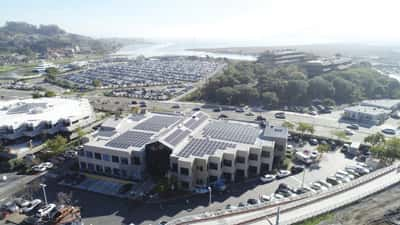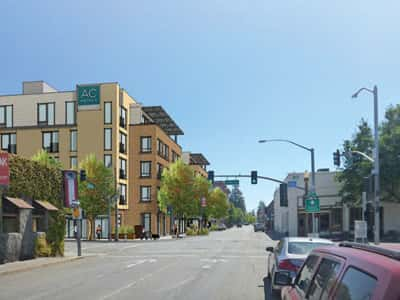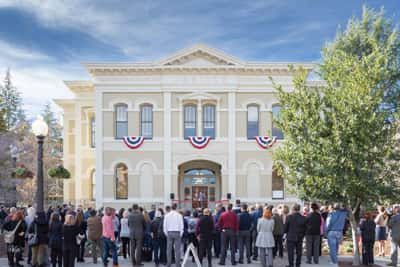Hospice by the Bay Going Solar
Hospice by the Bay in Larkspur has gone solar, thanks to SolarCraft, a North Bay leader in solar installation for more than 35 years. The addition of 433 high-efficiency solar panels will reduce HBTB’s carbon emissions and save thousand of dollars each month.

The first to offer hospice care in California, Hospice by the Bay has now embraced a more sustainable source of energy. For SolarCraft, the installation brought extra satisfaction, according to marketing manager, Kimberly Burnett. “Our team feels a special kinship with organizations that are working to improve the health and wellness of our community,” says Burnett.
The panels will not only benefit Hospice, but they’ll produce an excess of electricity, lessening the strain on the local power grid. Additionally, nearly 7.5 million pounds of carbon dioxide will be saved by HBTB—the same amount 176 acres of trees consume per year.
Based in Novato and Sonoma, SolarCraft is an employee-owned company and is the leading solar panel installer in the North Bay, with more than 7,000 customers.
For more information, visit solarcraft.com
Construction Trends: New Issues Meet Old
As technology becomes increasingly prevalent in all facets of life, construction is no different. However some traditional issues, such as supply and demand, are also top industry factors trending in 2019. And since the construction industry contributes to 20 percent of the world’s emissions, ways to reduce that footprint are also something to keep an eye on. Here’s a list of what to watch for in near future.

Updated Software: Digital tools to help manage your business have been around for a while, but the software is becoming more affordable and versatile. Programs are available in bundles that help with everything from accounting to billing and estimates.
Use of Drones: Drones have been trending for a while, but the fascination with these remotely controlled cameras in the sky isn’t slowing down. In addition to providing a view of otherwise hard to reach terrain, drones can collect data and complete safety inspections. The machines will cost less in 2019, making them more accessible, just as clarity on rules surrounding drone flight is expected soon.
Green design, Construction and Sustainability: Green design is aimed at creating efficient and environmentally-responsible buildings, through innovative design, construction and cleanup. Since 20 percent of the world’s emissions are a result of construction and infrastructure in the U.S. is aging and in need of repair, green design will be increasingly important. Structures with features such as accessible natural light or systems to recycle drain water also hold their value at a higher rate.
Modular, Prefabricated Buildings: Modular homes can reduce the impact to local landscape because they’re constructed offsite, and development can move faster because permits and financing can be secured at the same time as construction. Weather delays are rare because these dwellings are fabricated indoors. There is minimal waste because scraps are recycled and some modular homes can be moved to another site as the owner’s life changes.
Growing Material Costs: There was a 9 percent increase in material costs in 2018, and that trend will continue. The largest spike in price will come from iron, steel, manufactured steel and softwood construction lumber. One factor leading to rising prices is recently instituted import tariffs.
Better Safety Equipment: Technological advances will also help keep workers safer in 2019. Smart work boots with GPS transmitters, for example, can help detect fallen workers or employees that have slowed down due to fatigue.
Building Information Modeling: Also known as BIM, building information modeling is essentially a three-dimensional blueprint. Accessible electronically, these virtual models increase collaboration and are used for roads and utilities as well as structures. If the task of switching to BIM sounds daunting, consider a subcontractor to provide the expertise for you.
Source: thebalancesmb.com
Pre-Fab Hotel Breaks Ground
One of the latest construction trends will be on display at Santa Rosa’s Railroad Square by 2020, when the assembly of the 142-room AC Marriott hotel will be completed using structures prefabricated off-site. The units will be built in Boise, Idaho, and shipped to the corner of Fifth and Davis streets to be formed into a five-story structure. It’s one of the largest such projects in North Bay history, according to MW Builders, who will lead the project.

Bedford Lodging, which handles hotel development for Marriott, says off-site prefabrication is a sensible choice for Railroad Square. “Modular construction is for heavily dense areas, high populations, and states and cities where labor rates might be higher than other areas,” says Jeff Blackman, president of Bedford Lodging, in a prepared statement from MW Builders.
The hotel will include a bar and restaurant, fitness and conference rooms, retail space and a valet parking garage. It’s scheduled for completion in March 2020.
Napa Courthouse Reopens
The historic Napa County courthouse, closed since the 2014 South Napa earthquake, has reopened after construction wrapped up in January. The $13 million project began in September 2017 and was led by Alten Construction.
To make the building earthquake safe, substantial deconstruction was needed. Alten had to repair unreinforced masonry left from the original construction in 1878. They also tore down damaged brick walls and built walls made with concrete. “Historical projects are rewarding as new building techniques and materials are integrated with old,” says James Mitchell, senior project manager for Alten Construction. “What is most impressive is that the building looks exactly as it did before the earthquake.”

Alten reinstalled original interior elements such as wooden railings, window and door framing and courtroom benches to maintain the classic look of the courtroom. “It was very complex process,” says Mitchell. “We were able to bring brand new product, media and modern technology to the table while restoring a historic building.”
The Napa County courthouse is the fifth-oldest operating courthouse in California and will continue to be the home of Napa County government now that construction is complete.
Annual Sonoma County Homeless Count
Sonoma County’s annual tally of people living without a home was completed in January with the help of more than 250 volunteers and paid homeless guides working together. The count is essential in bringing federal funds to the county.
In addition, the mingling of volunteers and homeless participants helps to build a sense of community.  “Every single year, guides and volunteers end up going out to lunch together, or breakfast, staying in touch afterward,” says Michael Gause, homeless services manager for Sonoma County’s Community Development Commission. He adds that the paid guides are critical to the success of the tally.
“Every single year, guides and volunteers end up going out to lunch together, or breakfast, staying in touch afterward,” says Michael Gause, homeless services manager for Sonoma County’s Community Development Commission. He adds that the paid guides are critical to the success of the tally.
There are separate counts for homeless youth (age 18 to 24) and for persons living in shelters, jails and institutions. Gause also directs a phone survey that will estimate how many people are between homes, though that’s not required by the Department of Housing and Urban Development. There were approximately 20,000 such cases in last year’s count, according to Gause. Final results of this year’s count are expected in summer, 2019.
For more information, visit sonomacounty.cagov/cdc/
Author
-

Jean Doppenberg is a lifelong journalist and the author of three guidebooks to Wine Country.
View all posts




